Find out why bees buzz around white clover and how this relationship impacts our environment in ways you've never imagined.
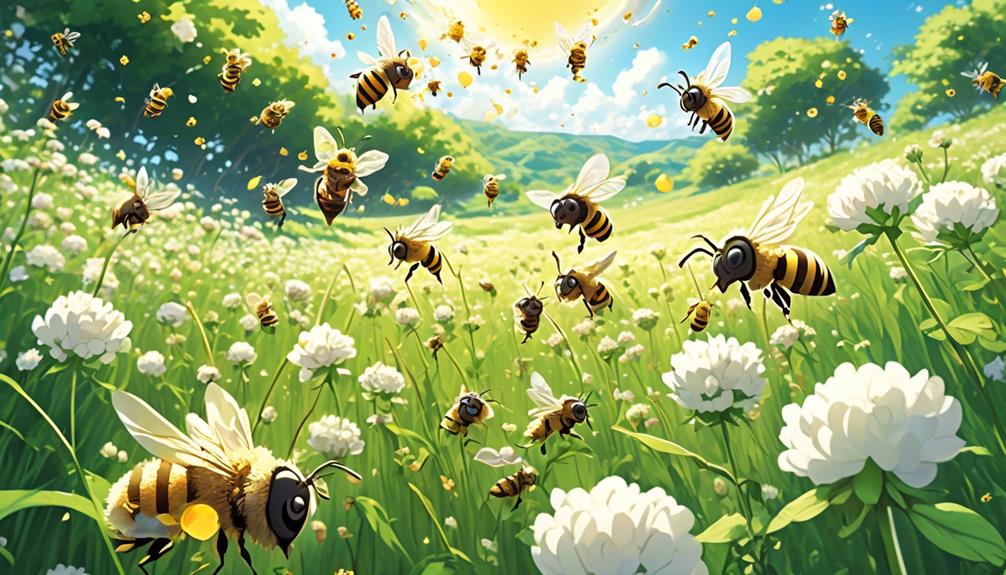
Do Bees Like White Clover?
Navigating the world of bees and their preferences is like deciphering a complex, buzzing code. You've probably noticed bees buzzing around white clover in your garden, but have you ever stopped to wonder why? It's not just a random choice; there's a fascinating relationship between bees and white clover that has impacts beyond your backyard.
Stay with us as we explore the intriguing details of this relationship and how it influences our environment. Curious about the role you play in this? Well, you'll have to stick around to find out.
Key Takeaways
- Bees and white clover have a mutualistic relationship, where bees collect nectar and pollen from white clover for nutrition and inadvertently transfer pollen grains to other flowers, enabling fertilization.
- White clover provides bees with rich sources of nectar and pollen, serving as a primary source of carbohydrates and essential amino acids for bees' immune response and longevity.
- Bees play a crucial role in the pollination process of white clover, collecting pollen from one flower and depositing it on another flower's stigma, which is essential for genetic diversity and survival of the clover species.
- White clover serves as a significant food source for bees, aiding in hive sustenance and reproduction, but a decline in clover or pesticide exposure can endanger bee populations.
Understanding the Bee-Clover Relationship
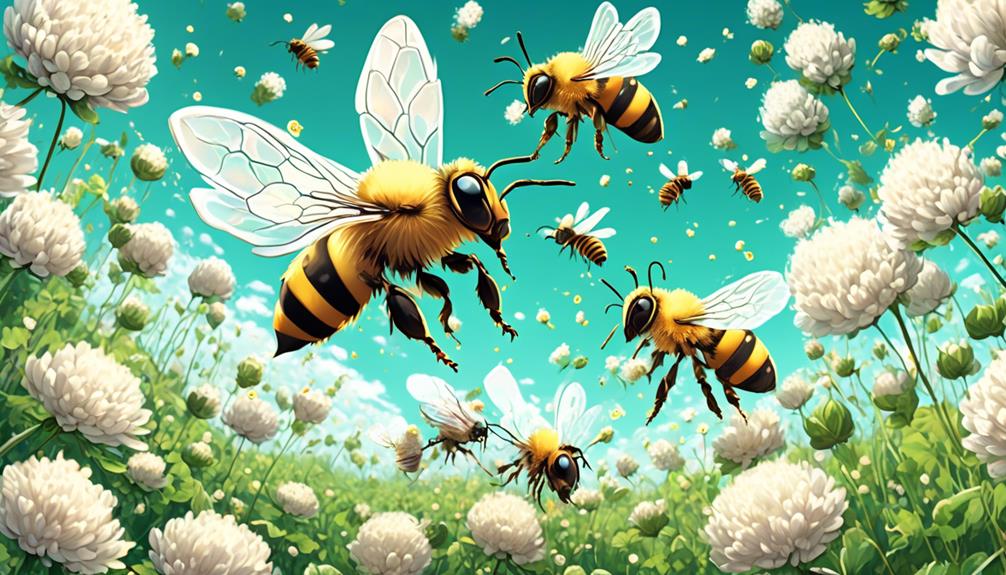
Often, you'll find bees buzzing around white clover, a relationship that's crucial not only for the survival of these insects but also for the propagation of this plant species. You might wonder why this connection is so important. Well, it's all about mutual benefits and the cycle of life.
In a process known as mutualism, bees and white clover have a reciprocal relationship where both parties benefit. For bees, white clover is a rich source of nectar and pollen, which they need for nutrition and hive sustenance. As they collect these resources, bees inadvertently pick up pollen grains that get stuck to their bodies.
When they visit another flower, some of these pollen grains rub off on the stigma, the female part of the flower, initiating the process of fertilization. This cross-pollination is vital for the white clover. Without it, the plant can't produce seeds and propagate.
The Nutritional Value of White Clover for Bees
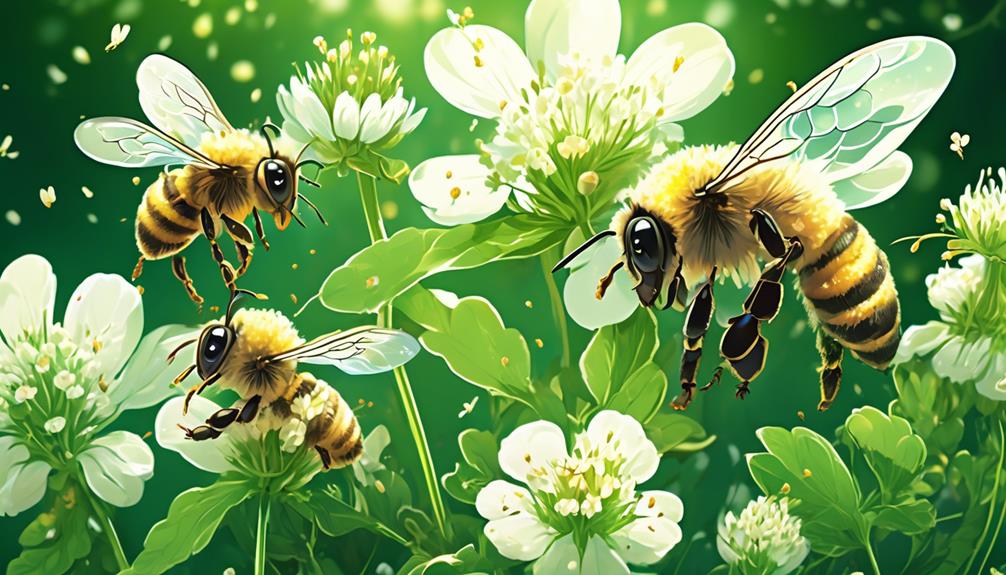
Building upon the significance of the bee-clover relationship, let's explore how exactly white clover contributes to the nutritional needs of bees. A key factor is that white clover is rich in nectar, a primary source of carbohydrates for bees, providing them with energy for flight and foraging. Additionally, the nectar contains essential amino acids that enhance their immune response and longevity.
White clover also offers pollen, which is crucial for bees. It serves as a protein source, needed for growth and reproduction. It's worth noting that the pollen from white clover has a higher protein content compared to many other plant sources.
Interestingly, the time of blooming of white clover aligns perfectly with the bees' active period. This assures them of a reliable food source when they need it the most.
In essence, white clover fulfills the bees' nutritional requirements in a balanced manner, supplying them with carbohydrates, proteins, and amino acids. It's not just about preference, but survival – white clover is a vital component in the diet of bees, contributing significantly to their overall health and population sustainability.
Thus, the bee-clover relationship isn't merely ecological, but nutritional as well.
Bees as Essential Pollinators for White Clover
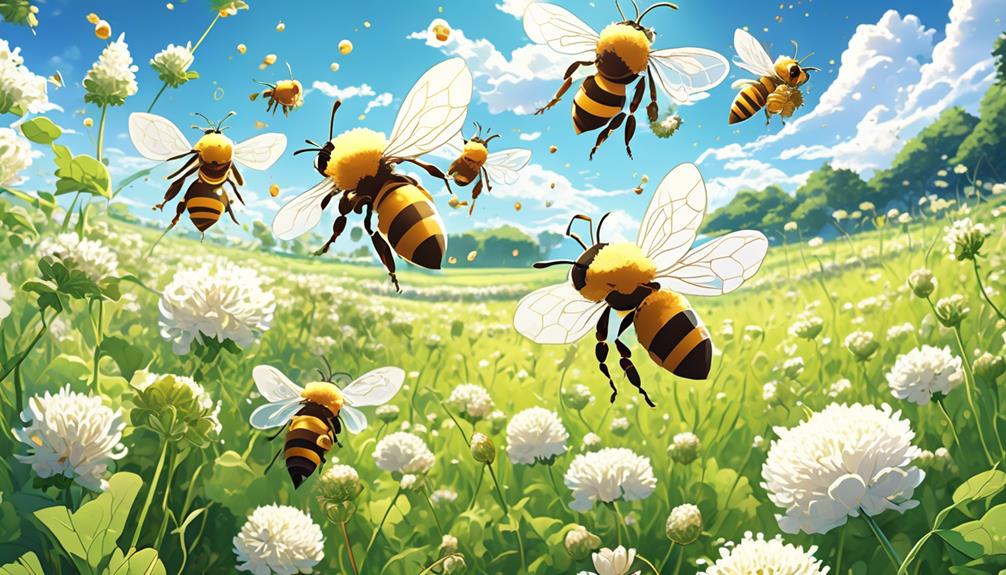
Have you ever wondered how crucial bees are to the pollination process of white clover? Well, they're indispensable. The complex interaction between bees and clover is an example of mutualism – a relationship where both parties benefit.
Clover provides bees with nectar and pollen, rich in essential nutrients. In turn, bees carry out the crucial task of pollination, assisting in the plant's reproduction.
As bees forage, they brush against the flower's anthers, picking up pollen grains. When they visit another flower, some of the pollen gets deposited on the stigma, the flower's female part. This process, known as cross-pollination, is essential for the genetic diversity and survival of the clover species.
Despite their small size, bees are mighty pollinators. They're responsible for the pollination of about 80% of the clover. Without bees, there'd be a drastic decline in clover populations, disrupting ecosystems and diminishing food sources for various wildlife.
Your understanding of the bee-clover relationship underscores the importance of biodiversity. It's not just about bees loving clover, it's about maintaining a delicate ecological balance.
Impact of White Clover on Bee Population
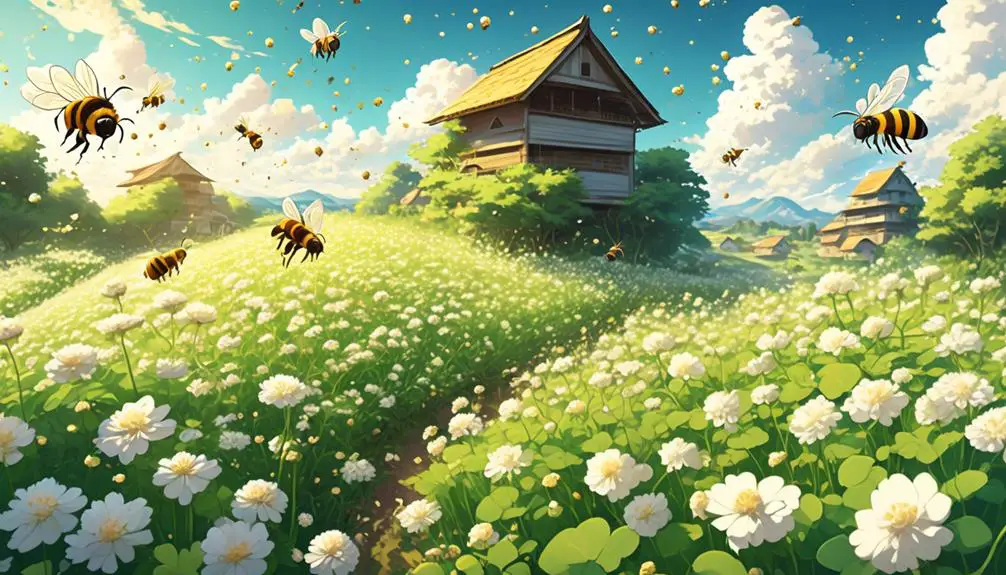
While you now understand the essential role bees play in pollinating white clover, it's equally important to recognize how the presence of this plant impacts the bee population itself.
White clover, rich in nectar and pollen, serves as a significant food source for bees. Its extensive bloom period, spanning from spring to fall, allows bees to have a steady supply of food, promoting their survival and population growth. As a bee feeds on a clover flower, it's also gathering pollen to transport back to the hive, aiding in the hive's sustenance and reproduction.
However, it's worth noting that reliance on a single plant species, like white clover, can expose bees to risks. For instance, a sudden decline in clover due to environmental changes could endanger the bee population relying on it. Similarly, bees feeding predominantly on white clover could be more susceptible to certain pesticides if clover plants are treated.
Threats to Bee-Clover Interaction
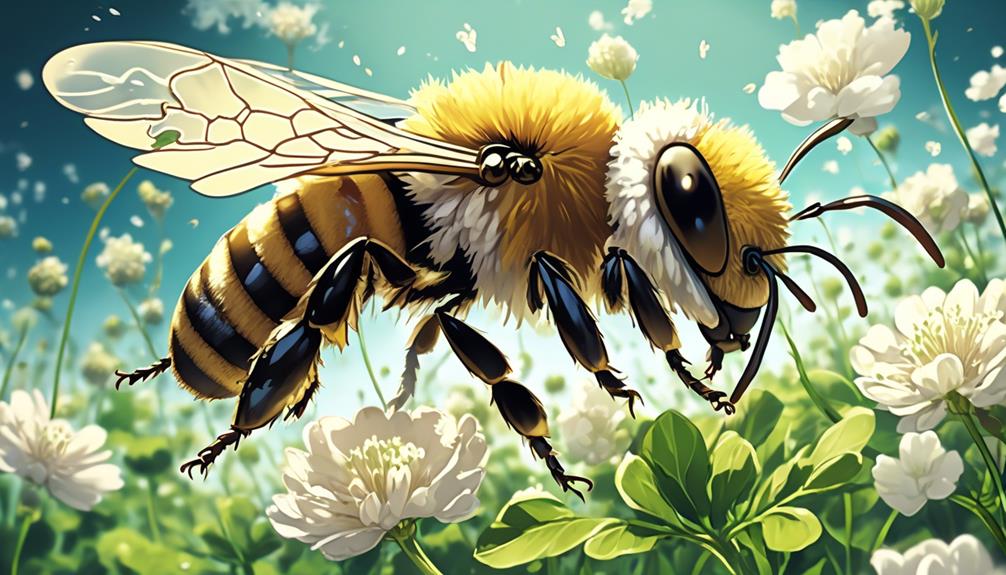
Despite the symbiotic relationship between bees and white clover, several threats jeopardize their crucial interaction. You should note that habitat loss, due to urbanization and intensive farming practices, reduces the availability of clover-rich fields, thus limiting bee foraging areas.
Pesticide exposure is another significant threat. Many pesticides, particularly neonicotinoids, have been linked to bee population decline. They're neurotoxic to bees, impairing their ability to forage, navigate, and reproduce. Moreover, climate change, with its erratic weather patterns, hampers the synchrony between bee activity and clover flowering. Early blooming due to warmer springs can result in a mismatch, leaving bees with insufficient food supply.
Invasive species also pose a threat. They can outcompete native clover species for resources, reducing their abundance and consequently the availability of nectar for bees. Finally, parasitic mites and diseases, such as the Varroa destructor and Nosema ceranae, weaken bee health, reducing their resilience to other threats.
As you see, multiple factors threaten the bee-clover interaction, making it essential to address these issues for the conservation of both bees and their beloved white clover.
Promoting Bee-Friendly Environments With White Clover
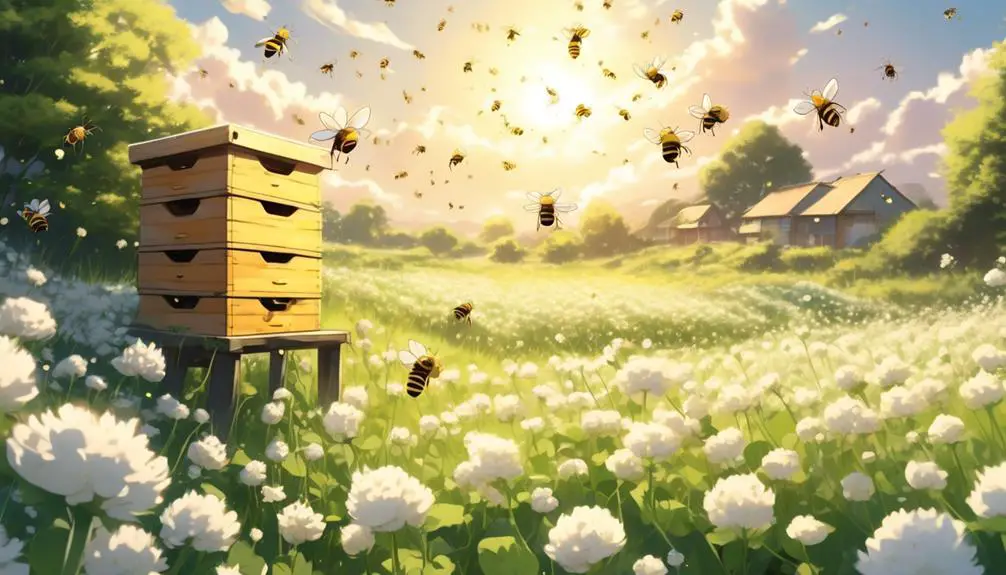
To counteract these threats and foster bee-friendly environments, it's crucial to promote the growth of white clover in our landscapes. White clover, scientifically known as Trifolium repens, is a perennial plant that's highly attractive to bees due to its nectar-rich flowers. It's a robust plant, which can thrive in diverse soil types and climatic conditions, making it an ideal choice for creating bee-friendly habitats.
When you cultivate white clover, you're not just providing a source of food for bees. You're also contributing to the biodiversity of your surroundings, as this plant plays a key role in nitrogen fixation, thereby improving soil fertility. Furthermore, its dense growth pattern helps in weed suppression, enhancing the overall health of the ecosystem.
However, it's also important to manage the clover growth. Overcrowding can lead to increased competition for resources among the clover plants themselves, potentially reducing the nectar production. Therefore, regular pruning and controlled fertilization are recommended to maintain optimal clover growth.
Frequently Asked Questions
What Other Flowers, Besides White Clover, Do Bees Like?"
You're curious about which flowers bees favor, other than white clover.
Bees can't resist flowers like lavender, coneflowers, sunflowers, and bee balm. They're also attracted to herbs like rosemary, thyme, and basil.
These plants not only provide nectar for bees but also attract them with their bright colors and strong scents.
Planting a variety of these in your garden will surely make it a bee paradise.
How Can One Differentiate Between Different Species of Bees?"
You can identify different bee species by observing their size, color patterns, and behavior.
For instance, honeybees have amber and brown bands while carpenter bees are shiny black. Bumblebees are larger, furry, and have distinct yellow and black bands.
Behavior-wise, honeybees and bumblebees live in colonies, but many other bees are solitary.
It's all about paying close attention to these details.
What Is the Lifespan of the Average Bee?"
Yes, bees absolutely love white clover. It's a fantastic source of nectar for them, which they turn into honey. You'll often see bees buzzing around patches of white clover in the summer months, tirelessly gathering nectar.
You can encourage bees to your garden by planting more white clover. It's not only good for the bees, but it's great for your soil too, as it's a nitrogen-fixing plant.
In What Regions of the World Is White Clover Most Commonly Found?"
You're likely to find white clover flourishing in temperate and subtropical regions worldwide. It's common in North America, Europe, and Asia, particularly in grasslands and meadows.
White clover thrives in well-drained, fertile soils and prefers full sunlight but can tolerate partial shade. It's a hardy plant, often used as ground cover due to its ability to spread and resist trampling.
Despite its global spread, white clover's origin is believed to be central Europe and Asia.
Can Bees Have a Negative Impact on White Clover Growth?"
No, bees don't negatively impact white clover growth. On the contrary, they help.
When bees visit flowers for nectar, they inadvertently carry pollen from one flower to another, thus assisting in cross-pollination. This process is crucial for the survival and reproduction of many plant species, including white clover.
Conclusion
In conclusion, you'll find bees are quite fond of white clover. Their relationship is mutually beneficial, as clovers provide essential nutrition for bees, while bees play a critical role in clover pollination.
Despite threats affecting their interaction, fostering bee-friendly environments with clover can positively impact bee populations. So, not only do bees like white clover, they also need it for survival.
Understanding this interaction is a crucial step towards promoting bee conservation efforts.



